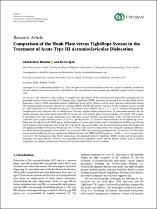| dc.contributor.author | Dündar, Abdulrahim | |
| dc.contributor.author | İpek, Deniz | |
| dc.date.accessioned | 2023-01-26T05:55:46Z | |
| dc.date.available | 2023-01-26T05:55:46Z | |
| dc.date.issued | 2022 | en_US |
| dc.identifier.citation | Dündar, A., & İpek, D. (2022). Comparison of the Hook Plate versus TightRope System in the Treatment of Acute Type III Acromioclavicular Dislocation. Advances in Orthopedics, 2022. | en_US |
| dc.identifier.issn | 2090-3464 | |
| dc.identifier.issn | 2090-3472 | |
| dc.identifier.uri | https://doi.org/10.1155/2022/8706638 | |
| dc.identifier.uri | https://hdl.handle.net/11491/8419 | |
| dc.description.abstract | Introduction. The objective of this study is to compare the effectiveness of the clavicular hook plate (HP) technique and the minimally invasive coracoclavicular (CC) fixation with a TightRope (MITR) procedure in treating acute unstable distal clavicle dislocation. Method. MITR (minimally invasive TightRope) group had 21 patients, and the open reduction and internal fixation (HP) group included 23 patients. Researchers compared MITR and HP (hook plate) outcomes for the treatment of acute type III AC joint dislocation in a retrospective analysis. The patients were followed up at 1 3, 6, and 12 months postoperatively. Complications were analyzed such as redislocation, fractures, implant-related complications, or subacromial erosion. For the clinical outcomes, the visual analog scale (VAS) (0: no pain, 10: worst possible pain), Constant-Murley score (CMS) (100: no pain, 0: maximum pain), the average satisfaction score with their current shoulder function (range: 0-10), and the University of California at Los Angeles Shoulder score (UCLA) (> 27 good/excellent < 27 fair/poor) were recorded at the last follow-up. Result. There were 21 sufferers in the MITR group, which comprises 19 males and 2 females and 23 individuals in the HP group (20 men and 3 women), with average ages of 43.9 and 39.2, respectively. Age, sex, laterality, and the interval between injury and surgery did not significantly differ between the two groups (0.357, 0.792, 0.432, and 0.55, respectively). No statistically significant difference was found between the groups in terms of the VAS score and CMS score at one year postoperatively. The mean CCD at the initial trauma and last follow-up was not significantly different between the MITR and HP groups (p = 0.365, p = 0.412 respectively). Conclusion. For treating acute type III AC dislocations, the minimally invasive TightRope (MITR) system and the hook plate technique were great options. However, the minimally invasive TightRope system showed further benefits such as reduced reoperation for implant removal and reduced risk of subacromial distal clavicle osteolysis. | en_US |
| dc.language.iso | eng | en_US |
| dc.publisher | HINDAWI LTD | en_US |
| dc.relation.ispartof | ADVANCES IN ORTHOPEDICS | en_US |
| dc.rights | info:eu-repo/semantics/openAccess | en_US |
| dc.title | Comparison of the Hook Plate versus TightRope System in the Treatment of Acute Type III Acromioclavicular Dislocation | en_US |
| dc.type | article | en_US |
| dc.department | Hitit Üniversitesi, Tıp Fakültesi, Cerrahi Tıp Bilimleri Bölümü | en_US |
| dc.authorid | 0000-0003-2617-2073 | en_US |
| dc.relation.publicationcategory | Makale - Uluslararası Hakemli Dergi - Kurum Öğretim Elemanı | en_US |
| dc.identifier.doi | 10.1155/2022/8706638 | en_US |
| dc.description.wospublicationid | WOS:000900142900001 | en_US |
| dc.description.pubmedpublicationid | 36518907 | en_US |


















